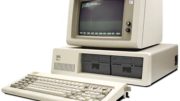That’s right, campers. As of yesterday, the Sprint name is officially retired. So ends a long and sordid tale which I have enjoyed telling for decades. Some of my anti-Sprint rants are on this blog, but the bulk of them over the year have been verbal.
The sad early history of Sprint
The fairytale history of Sprint seems to have started from two different directions. The first was United Telephone, an AT&T competitor from the 19th century. United Telephone was, inexplicably, still part of the local telephone landscape in the 1990s.
The other half of Sprint’s longtime parentage came from the Southern Pacific Railroad. Supposedly (and I have some doubt as to this) the company laid telegraph lines for its own internal communication. This system supposedly had the prudent name of “Southern Pacific Railroad Internal Networking Telecommunications.” In other words, “Sprint.” In other other words, someone had way too much time to play with acronyms.
GTE, another strong provider in the telecom space, bought the Sprint lines from Southern Pacific in the early 1980s and then bought United Telecom completely. The company launched “US Sprint” as a long-distance competitor shortly after that.
Where the troubles began
US Sprint dabbled in cell service in the 1980s, but that part of their business was spun off as the company continued to grow. Their return to cell service came in the mid-1990s, known at the time as “Sprint PCS.” It was always a second-tier company.
From there, the company embarked in a series of questionable mergers leading to a string of dead-end technologies. Perhaps the best known was their 2004 purchase of Nextel. You might remember Nextel as the company that sold the most annoying phones in the history of phones. Their chirpy push-to-talk technology was an early precursor to texting, a way to have a communication without a conversation.
Nextel’s obsolete technology, Sprint’s old-school cell phone tech, and their power-hungry 4G service were only some of the bad technologies the company offered in the 2000s and early 2010s.
Sprint in the crosshairs
Perhaps Sprint’s lowest moment, in my opinion, was a three-way kerfuffle where Japanese company Softbank attempted to buy the company, supposedly for its Clearwire technology. Clearwire was another failed high-speed internet venture that might have seemed more interesting back then than it really was. Softbank ran into headwinds because of its use of Huawei parts. Even back then there was a feeling like Huawei couldn’t be trusted. In the meantime DISH stepped in, eager to get into the wireless space. It was a huge mess for a few months until it all got sorted out.
In the end, Softbank stopped using Huawei tech in the US, bought Sprint, and no one has heard of Clearwire since.
And then, T-Mobile
Almost the moment that the dust cleared after the whole Softbank thing, we started hearing that T-Mobile was interested in Sprint. I was wildly against the idea at first and never really warmed to it. But, as the years went on, Sprint’s older tech faded away, and T-Mobile was left with only its current low-tech cell phone network and weird bandwidth model. I have a feeling those problems will fade in a few years as well.
And of course DISH got in on the action, buying up Boost Mobile to enter the cell phone service arena. So that was a win for them.
A fitting tribute
And so, as I said, I expect this to be the last article I write about Sprint. They’ll fade into the halls of history along with so many other companies we don’t think about anymore.





